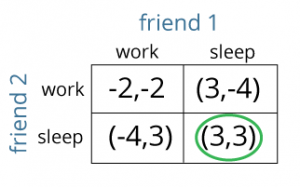Game Theory of Everyday Decisions
Everyday people make multiple decisions, both big and small, where they evaluate options and make decisions based on what their friends and family are doing. Larger decisions range from deciding whether to accept a new job and quit an old one, move to a new city, or start a new relationship. In general, we are more aware of our own thought processes in weighing the different actions we can possibly take when our decisions are big and have an important impact on our lives. However, we also make lots of small decisions, where we are not as conscious of our decision making process and evaluate our options quickly. Both types of decisions are influenced and can be explained in part by game theory. Game theory allows us to examine how players act and implement strategies in different situations or games.
Let’s take the example raised in the article, of a small decision that many people make everyday. Lets say there is a husband and wife, and they both hold important jobs where they are often required to work late. In this situation or game, each player, the husband and the wife, have two strategies they can play, go home early or go home late. Assuming these decisions are made simultaneously, this would be classified as a non-cooperative game, and therefore there might exists a Nash equilibrium given the payoff structure shown below. A Nash equilibrium is a a situation where no player can pick an alternative strategy and be better off, if the other players maintain their strategy.
In the example above, there exist two Nash equilibria. The first is if both the husband and wife go home early, and the second is if the husband and wife both go home late. These are both Nash equilibria because in these two cases, neither player can improve their payoff by changing their strategy.
Another example where there is a Nash equilibrium in an everyday decision is one that Cornell students often face. There are two friends, each with two strategies, stay up late and work or go to sleep. In this case there is only one Nash equilibrium because of the payoff structure. The work payoff is negative because working is not an enjoyable activity, however, working is less of an annoyance when you are working with friends. However, sleeping early is positive experience, where the payoff is consistent regardless of what your friends select to do. The Nash equilibrium is demonstrated in the diagram below.
Game theory underlies most decisions that people make, and as demonstrated, even the seemingly smallest situations can be represented by games.
http://www.slate.com/blogs/quora/2014/07/16/nash_equilibrium_how_did_the_mathematical_concept_impact_game_theory_and.html


